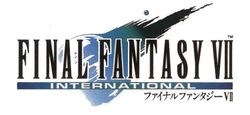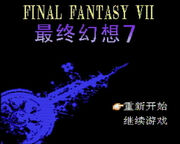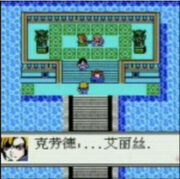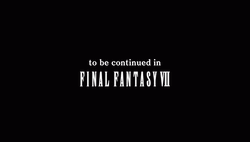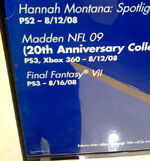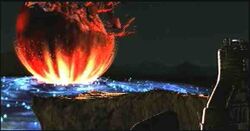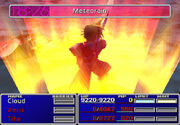- An energy manufacturing mega company known as Shinra Inc. is harvesting the sheer life energy of the Planet (known as the Lifestream) as a simple fossil fuel. The Lifestream is processed and made into products ranging from electricity and heat to Mako and Materia. The latter two materials can work miracles, granting the wisdom of the Ancients to the user. However, the Lifestream, like most other fuels, is finite in supply, and the Planet's lifeforce is being malevolently drained by the constant exploitation of Mako by Shinra. Though aware of the harmful effects, they function without remorse.
- However, the real battle lies not with a corporation, but a force much more competent from the distant past. A long-thought dead warrior bent on becoming a god by draining all of the Lifestream from the planet has risen again and will stop at nothing to achieve his goal.
- "Now a small rebel group emanating from the slums must quell the various dangers toward the innocent, and one mercenary for hire must look amidst the lies and deception and find the man he is within."
- —Official Introduction
[edit] Background
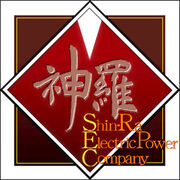
The Planet, occasionally called Gaia, is the world of Final Fantasy VII. It is technologically advanced, with many of the modern inventions of the real world, such as cars, television, firearms, and cellphones. Their world is dominated by Humans, who are the only major race other than a few nearly extinct species. It is economically, militarily, and politically dominated by a powerful conglomerate called the Shinra Electric Power Company, which profits from the use of machines known as "Mako Reactors". These reactors siphon a special type of energy - called "Mako" - out of the Planet and convert it into electricity. One of the by-products of the extraction and refinement of Mako energy is materia, a concentrated form of Mako which allows the owner to use its magical properties. President Shinra leads his eponymous organization, and is thus the de facto ruler of the world. Shinra is involved with many horrible genetic experiments, which have created many of the monsters that roam the Planet.
In actuality, Mako energy is drawn from the Lifestream, a flow of life-force beneath the surface of the Planet. All life originates from the Lifestream, and returns to it upon death. In short, the Lifestream is the sum of all the life that has ever and will ever walk upon the Planet. The process of extracting Mako energy literally drains the life of the Planet in order to generate electricity. This can be seen quite clearly in the Shinra's capital city of Midgar, where the eight Mako Reactors have sucked out so much of the Planet's life-force that the area is covered in perpetual darkness and no plants can grow.
Shinra's management is concerned with the limited repositories of Mako energy available for harvesting, and fascinated with the idea of a "Promised Land"; a place where the land is incredibly fertile and where Mako flows abundantly. Only a race called the Cetra, or the Ancients, are, according to legend, able to find it. However, the Cetra were all but driven to extinction by the "Calamity From the Skies", the alien creature Jenova. All are lost except for one Cetra, Aeris Gainsborough, whom Shinra has been trying to capture for years.
[edit] AVALANCHE
The game opens in Midgar, and for the first few hours of gameplay the player can only travel within the city. Inside the city's slums is a rebel resistance group of eco-terrorists called AVALANCHE, a major threat to Shinra. AVALANCHE is led by Barret Wallace, a former denizen of Corel, a town destroyed by Shinra thus creating the fuel for Barret's crusade against the company. AVALANCHE hires a mercenary named Cloud Strife, who claims to be a former member of Shinra's elite special forces team, SOLDIER. But Cloud is plagued by psychic disturbances, and is far more than he seems. He shows little interest in AVALANCHE's cause at first. By his own admission, Cloud is interested only in the money. Other members include Cloud's childhood friend, Tifa Lockhart, whom Cloud made a promise to protect back before he left to join SOLDIER, and the minor characters Jessie, Biggs and Wedge.
Their mission is to blow up the eight Mako Reactors that ring the city, without care to the human consequences. Along the way, Cloud is separated from the rest of the team and meets up with Aerith Gainsborough. To counter AVALANCHE's attacks, Shinra carelessly drops the Plate upon their base in Sector 7, killing all the non-player characters in the group. Aerith is captured by Shinra and taken to their Headquarters. Cloud and the remains of AVALANCHE storm the Building to rescue Aerith. They manage to save Aerith, and a test sample, Red XIII, but then the entire group is captured. They are saved by the surprise reappearance of the supposed dead legendary SOLDIER, Sephiroth, following the escape of a headless Jenova from her tank. President Shinra himself is killed in Sephiroth's return. The young and ruthless Rufus Shinra takes the reins of Shinra following his father's death, and Cloud and his party manage to make a hair-thin escape from Midgar only by fighting their way through the ranks of Shinra forces.
[edit] Chasing Sephiroth

Sephiroth, silhouetted by the flames of Nibelheim; variations of this shot appear in several games
The rest of the game allows the player to explore the World Map and the other towns throughout. At the first town the party comes to, Kalm, Cloud tells his tale of what happened five years ago, but it is filled with holes and gaps. Five years before the beginning of the game, Cloud and Sephiroth were sent to Cloud's hometown of Nibelheim to investigate the Mako Reactor there. Inside, Sephiroth found Jenova, a creature Shinra mistook as an Ancient and whom had been called Sephiroth's mother. Sephiroth begins to look deeper into his past and the Jenova Project from which he was born. It was led by Professor Gast and the deranged Professor Hojo. What he finds drives him insane. Believing himself to be the last Ancient, Sephiroth begins to take revenge on humanity by burning Nibelheim to the ground. Lost in the fires is Cloud's mother and Tifa's father. Cloud runs up to confront Sephiroth, but his recollection fails him before he can reach the end of the story.
From then on, the party chases after Sephiroth across the Planet, traveling to many towns, meeting many characters, and getting into different adventures. They do not search alone, as Rufus Shinra has sent out Shinra's full might to take Sephiroth in, including sending the Turks, a group of Shinra special operatives. The party fights the Turks several times during the course of the game. In Gold Saucer they meet Cait Sith, a fortune teller robot who is secretly controlled by Reeve, a Shinra Executive who is actually interested in doing good. At Rocket Town, Cid Highwind, an aeronautical engineer whose dreams of going into space had been dashed by Shinra's lack of funding, joins the party. Two secret characters, Vincent Valentine and Yuffie Kisaragi can join any time the player pleases. Vincent is a former Turk who was betrayed by his love, Lucrecia Crescent, Sephiroth's biological mother, and turned into a monster. He sleeps beneath the Shinra Mansion in Nibelheim, in penance for his sins of failing to stop the Jenova Project. Yuffie is the princess of Wutai, a town that fought against Shinra dominance before the game began, but has since submitted. She dreams of restoring her homeland's pride.
The party's pursuit of Sephiroth leads them to discover several things. Sephiroth's plan is to use the Black Materia, a Materia so powerful that the Cetra hid it away to stop its use. The Black Materia contains the spell Meteor, the ultimate Black Magic. It can summon a giant meteor to crash into the surface of the Planet. Sephiroth's plan is to create a wound in the Planet so large that the Lifestream will need to be sent en masse to heal it. Here, Sephiroth will intercept the Lifestream and take complete control of the world. Sephiroth is followed by a group of black-robed fanatics, the Sephiroth Clones. The Clones all gradually die out along their journey; none of them are actually able to reach Sephiroth. Cloud's party moves to grab the Keystone required to open the Temple of the Ancients. It is held by Dio, the leader of Gold Saucer. During their stay at Gold Saucer, Cloud goes on a date with one of his fellow party members. Depending upon the player's actions according to the hidden value system of Date Mechanics, Cloud can date either Aerith, Tifa, Yuffie, or Barret. The game is rigged so that Aeris and Tifa are the most likely candidates, while Yuffie and Barret take conscious effort to achieve, and have a less serious tone than the other two. After the date, Cait Sith steals the Keystone and hands it over to Shinra.
Inside the Temple of the Ancients, Sephiroth attacks the leader of the Turks, Tseng, seeming to kill him. Due to a mistranslation, international players of Final Fantasy VII were told that Tseng was in fact dead; though he in fact remains alive and reappears in later games. Cloud and his party find that the Temple is the Black Materia. To make into a usable form, somebody must be left inside while the Temple shrinks. Cait Sith volunteers, and after an extended scene in which he speaks of noble sacrifice, he is destroyed once the Temple turns into a Materia sphere. Cloud takes the Materia in his hand, now certain of the Planet's safety. Due to Sephiroth's control over him, Cloud hands Sephiroth the Black Materia, and almost kills Aerith. As Cloud falls unconscious, another Cait Sith appears, exactly the same as the first (perhaps mocking the trend in RPGs for characters to die and be ressurected). After this, Aerith permanently leaves the party to find an independent way to save the world from Meteor.
Aerith travels to the Forgotten Capital, the lost city of the Cetra, where she plans to summon Holy. Holy is the ultimate White Magic, a counter to Meteor used to stop its power. Cloud's party makes their way up to the ruin to chase after her and Sephiroth. When they arrive, Cloud is almost brought to kill Aerith by Sephiroth's control, only being snapped out of his thrall by the intervention of his comrades. Aerith is then savagely murdered by Sephiroth; he impales her through her torso with the Masamune in one of the most infamous and shocking scenes in Final Fantasy history. Cloud is enraged at Aerith's death, and the cavalier attitude Sephiroth has about it. Sephiroth only taunts Cloud, telling him he should not act as though he has feelings. Floating up into the sky, the "Sephiroth" turns out to in fact be Jenova. The person the party hunted after for so long was actually Jenova under Sephiroth's control and taking his form. After a battle with a piece of Jenova, and the party paying their respects to the departed Aerith, Cloud lays Aerith's deceased body to rest in the waters of the Forgotten Capital. Cloud decides to continue on the journey to complete his revenge against Sephiroth, even knowing that he may lose control of himself again at any time.
Despite the loss of Aerith, the party continues to follow the Sephiroth/Jenova. They finally reach the end of the journey, the Northern Crater created by Jenova's fall thousands of years ago. They move into the Crater, hoping to finish the battle. They are joined by Rufus and his gang, flying on the Airship Highwind. Cloud along with Tifa and another selectable party member go up to confront Sephiroth. However, all they find is Sephiroth, showing an illusion of events in Nibelheim. Sephiroth shows Cloud never being in Nibelheim, his role in the story taken by Zack Fair. Tifa, though telling Cloud not to believe them, cannot refute Sephiroth's claims, and Cloud begins to believe they are true. Furthermore, Sephiroth says that Cloud is not Cloud at all, but a facsimile created by Hojo, and a mere puppet. Rufus lands but is forced to leave by an upsurge of Mako. During this time, a completely controlled Cloud hands Sephiroth the Black Materia, after which he apologizes to Tifa for what he's done and falls into the Lifestream. Meteor is now summoned by Sephiroth. This causes the Planet to become violently self-protective, awakening its guardians, the WEAPONs. The WEAPONs are giant monsters of immense strength and destructive power. The party escapes on the Highwind. Tifa is knocked unconcious in the escape, Barret is caught as he tries to escape with the unconscious Tifa, and the both of them are taken to Junon. The rest of AVALANCHE escapes on their own, but how is not detailed.
[edit] Meteor Falls
Tifa awakes in Junon seven days after the events in the Crater. She finds a world in total chaos due to impending calamity floating in the skies. Meteor is visible in the sky as it moves towards the Planet a sign of the impending end of the world. To stop attacks against himself, Sephiroth has surrounded the Northern Crater with a shield. Rufus, trying to show that Shinra still has some control over the situation, decides to use Tifa and Barret as scapegoats. They will be publicly executed in front of the entire world. Just before the execution can go through, a WEAPON attacks (though never stated in-game, this is the Sapphire WEAPON). Using a giant Mako cannon, the Sister Ray, Shinra successfully fires right through the monster, destroying it. What remains of the party manages to sneak by during the attack to rescue Tifa and Barret, and steal the Highwind out of Junon.
Afterwards, the party finds Cloud suffering from severe Mako Poisoning in the town of Mideel. Though Cloud is completely lost, Tifa decides to stay behind and watch over him. Lacking a better substitute, Cid Highwind becomes the party leader. He leads the party to fight against Shinra's plan to stop Meteor. Shinra schemes to load the Huge Materia onto Cid's rocket and launch it directly at Meteor. Depending on the player's actions, all or none of the Huge Materia can be saved. The storyline is not changed, Shinra's plan fails no matter what.
In Mideel, the Ultimate WEAPON crashes out of the Lifestream right in the middle of the town. Mideel is destroyed while Cloud and Tifa are still inside. They fall into the Lifestream. Here Tifa is able to travel inside Cloud's Subconscious and sort through Cloud's true memories and secret desires, such as joining SOLDIER in part to gain Tifa's attention. She confirms that Cloud is the genuine article, though his mind had been damaged due to a variety of reasons. Cloud's mind had shattered as a result of Hojo's experimentation and Zack's death, and he merged his own ideal self with Zack and Tifa's memories, and replaced Zack with himself in all his memories. Cloud reveals he never was in SOLDIER, failing to be mentally strong enough to enter the organization. Due to Cloud's fear of seeming a failure to Tifa and his hometown, he hid under a helmet during his mission in Nibelheim with Sephiroth. Despite all this, it turns out Cloud did defeat Sephiroth during the Nibelheim incident, managing to overpower Sephiroth and fling him into the Lifestream. After these revelations, Cloud's psyche is restored to its true state, and he returns as the leader of the party.
With help of the Cosmo Canyon elder Bugenhagen, the party manages to uncover the mystery behind Aeris's death. She summoned Holy just before her death, but the spell is being held back by Sephiroth deep within the Planet. At that moment, the Diamond WEAPON rises out of the sea and begins its charge towards Midgar. Rufus and the Shinra Executives moved the Sister Ray to Midgar before the attack to prepare for an offensive against Sephiroth. The Mako Cannon is used to destroy the WEAPON, and the blast continues to reach Sephiroth in the Nothern Crater, breaking the shield. Just before the WEAPON is killed, it fires out its energy blasts into the Shinra Building, destroying Rufus and the heart of his organization. Midgar falls into chaos.
Cloud's party moves into the city to fight Hojo who has taken command of the Sister Ray. They fight their way through the Turks and the remaining forces of Shinra to reach Hojo. There Hojo reveals he wishes to give his son a boost by giving the Sister Ray's power; the party is horrified to learn Hojo is Sephiroth's father, although Sephiroth does not know it, and thus Hojo is directly responsible for the crisis facing the planet. If Vincent is in the party, he will declare that he was not the one with a sin, it was Hojo who should have slept for so many years. Despite the power he has gained by injecting himself with Jenova cells, Hojo is defeated.
Following the attack, with only a week until Meteorfall, Cloud and his party decide to rest and return home before the final battle against Sephiroth. Without any place to call home or anything else to fight for, Cloud and Tifa share the night alone together below the stars. The next morning it turns out that all of the party had returned and several of them poke fun at Cloud and Tifa's expense, much to Tifa's embarrassment.
The final battle against Sephiroth is fought deep inside the Northern Crater. Sephiroth transforms his body first into Bizarro Sephiroth and then Safer Sephiroth, a half-human, half-divine form that shows Sephiroth's attempts to become a God. Despite Sephiroth's immense power, he is defeated. Cloud then fights a mental version of Sephiroth inside the Lifestream, which is also beaten, freeing Cloud of his mental chains to his enemy. However, the victory comes too late. When Holy is released, Meteor has fallen too far for Holy to unleash its full power without drastic collateral damage. Midgar is destroyed by the struggle of Meteor and Holy, but before the entire Planet is lost, the Lifestream congregates below, forcing Holy and Meteor far enough away from the planet for Holy to unleash its full strength and destroy Meteor. The game ends in a flash of light, followed by Aeris's face, smiling.
An epilogue shows Red XIII and several small pups over the overgrown ruins of Midgar, showing that life has continued after the disaster. The ending was left very vague, leading to many questions asked by confused players over the fate of humanity and where the pups came from, among others.
From : http://finalfantasy.wikia.com/wiki/Final_fantasy_7
